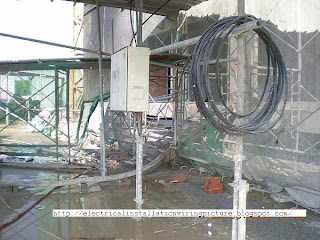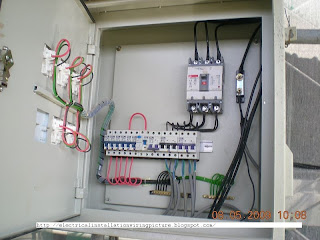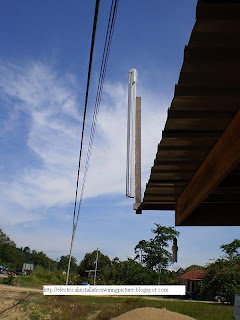Picture 1 - Incoming electricity supply cables on concrete poles

=================
RELATED ARTICLES: A simple electrical installation | Electrical socket extension unit | 1- Phase ELCB connection pictures | Bare fluorescent light pictures | Recessed down lights installation | Bollard light pictures | Light switch installation pictures | Home wiring pictures | Electric Meters | Electrical Grounding Electrode Pictures | Most Basic Principles of House Wiring | MATV antenna bracket pictures
=================
The electrical current that goes into our home comes from the electricity supply company's distribution network, usually in the form of overhead cables running on concrete poles (Picture 1 above) or using cables buried one meter below the ground.
When the cables reach a residential house, they usually enter the house through the front entrance and connect to a meter panel (See Picture 2). Together with the meter on the panel is also a cut-out fuse. The meter and the fuse usually belong to the supply company.
From the meter panel the electrical cables are routed to the home electrical panel. On the panel is usually an isolation switch, a leakage protection circuit breaker and a few outgoing fuses or outgoing circuit breakers (See Picture 3).
From the outgoing fuses or circuit breakers the wiring cables run above the ceiling, inside or on the surface of the wall, or concealed inside the concrete floor to go the lamps, ceiling fans, socket outlets and other equipment like the toilet exhaust fans in our homes.
When a home user connects an electrical appliance to a socket outlet, the connection is usually made by the use of an electrical cord. One end of the cord has a plug unit (sometimes the plug unit contains a fuse) that is inserted to the power socket (i.e. wall plug). The other end will be plugged to another socket already built-in on the appliance.
Now and then the location of the electrical appliance needs to be quite a few meters away from the wall socket outlet. The electrical cord provided with the appliance is usually between one to one and a half meters long. In these cases home users usually purchase an extension cord to connect between the wall socket and the appliance's electrical cord (Picture 4 shows an example of electrical extension cords).
From the viewpoint of the electrical current flow, the supply uses only two wires. That is why in some countries or regions we can see only two big wires coming down from the electric pole to a house. One of them is called the live wire, "hot" wire or phase wire. It is this wire that is "dangerous".
The second wire is called the neutral wire or the "return" wire. The electric current flow into the house will come out again (i.e. return) in the same magnitude and goes back into the supply company's transformer or generator. This electrical path forms a complete "loop", like a circle. The continuous and circulating flow of this electrical current is what makes the filament inside the house incandescent lamp burns and produce light that brightens our house.
This behavior of the home electrical system brightens and enriches our lives. When used and handled properly, electricity is very useful and friendly. It is however very powerful and dangerous, and therefore must be treated with respect.
With the two wires described above, we can have electricity in our home that can keep our food fresh in the refrigerator and replace the candles to light up the house during the night.
However with just these two wires, it is like driving a car at high speed without the brake. Driving the car without a brake is extremely dangerous even on an empty freeway that has no traffic light for hundreds of kilometers at three in the morning. As in driving, we need to step on the brake now and then to slow down, or during an emergency.
In a home electrical wiring system, this braking is accomplished through a third wire, the earth wire. Many electrical terms are commonly used for this wire such as earthing wire, ground wire, chassis wire or protective wire.
In a house, this earth wire is almost always colored green or green with yellow stripes. The wire connects the metal casing of the electrical appliance in our homes to the "earth body". (Really, it is actually connected to the huge mass of the earth.)
When the "hot" or live wire somehow come into contact with the outer metal casing of your washing machine, for example, then the fuse at the distribution board will immediately blow, stopping the current flow to the metal casing of the washing machine so we do not get the shock, a fatal shock actually. Where the distribution board uses a circuit breaker instead, the circuit breaker immediately trips, cutting off the supply just like the fuse does.
If the green wire is broken, or it does not connect properly along its path to the earth body, then the electrical power has no brake. The person touching the washing machine's metal casing can get electrocuted.
So do treat the electrical wiring and electrical appliances in your home with respect. Safety comes first. In future articles I will explain more on the "earth wire" and I will also give more tips and techniques on how to make sure your home electrical system is safe for you and your family.
Picture 1 - Incoming electricity supply cables on concrete poles

Picture 2 - Supply authority's meter panel at house entrance or main door

As you can see in Picture 1, the cable coming from the concrete pole is a twisted two-core cable. Two-core means there are actually two lengths of cables in the cable set and they are twisted around each other. The twisting construction of the cable is primarily to make it better to handle, more flexible to bend around and also make it to install on to of the electric poles.
Observe that the cable run along the terrace houses just below the ceiling at the external front wall of the houses. That's why you see in Picture 1 that the cable drops from the concrete pole to only the first house unit in that row.
The energy meter is located approximately near and above the main door, just outside the house. The utility company's meter readers can read the meter every month without disturbing the house tenants. The meter you see in the picture is one of the conventional types. The meter reader needs to get close enough to be able to visually read the meter reading.
However nowadays a much more hi-tech type of meter is getting more popular. I will provide you with a picture of this type soon. The new type is more like a remote control kind of thing. The meter reader does not need to read the energy meter visually. He carries with him a handheld unit the size of a walkie-talkie.
In front of the house main gate he just points the device towards the meter unit and presses the "read" button. The data of the meter is transmitted automatically to the handheld unit, and the latest energy bill is immediately issued to the home customer. He does not have to open the house main gate to get close enough to the meter on the wall to read it.
Back to the meter panel. The supply is tapped off from the horizontal cables, and run down to black components near the meter. One is the service fuse and the other is the "Neutral" link. The meter is separated from the incoming supply by these two components.
So when you do not pay the electricity bill, the company takes off the service fuse and takes it back to their office. So the electrical circuit is broken on the "Live" side, cutting off the supply. The good news is your electric meter will not go up any more.
From the meter unit, two wires will connect the meter to the consumer electrical panel inside the house, which is also called the consumer unit or distribution board (DB). You cannot see the connection between the two because connection to and from the meter is done inside the wooden panel that is used to mount the meter, fuse and the neutral link.
From behind the wooden panel the cables run concealed inside the wall to the electrical panel. The cables can actually be run on the wall or ceiling surface, but in the example inside the pictures, they are run concealed inside the walls.
Picture 3 - Home electrical panel

Picture 4 - Electrical extension cords

Picture 5 - Electrical appliances connected to wall socket

Picture 6 - The green "earth wire"

I know a few more pictures will help some readers understand the house wiring better. I will upload a few more suitable pics as soon as I can. There will also be more comments to the pictures similar to what I have done to Picture 2 above. But I have to rush off now.
Will see you again after a few days.
Note: You can also see more pictures of electrical wiring by visiting this post, Pictures of electrical wiring.
Copyright Electrical Installation Wiring Pictures - Home wiring pictures















